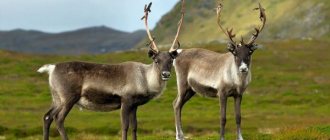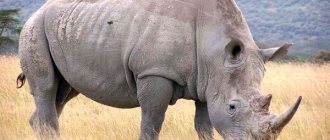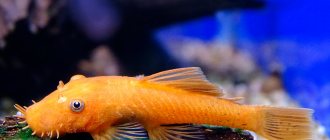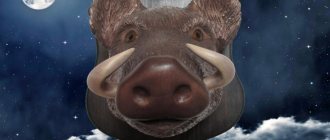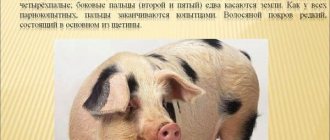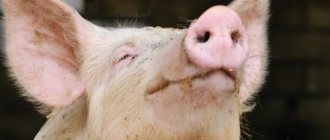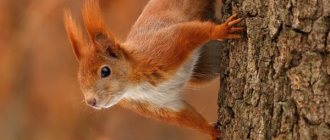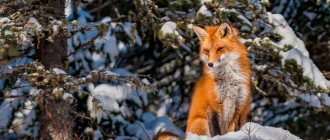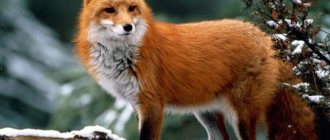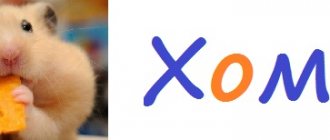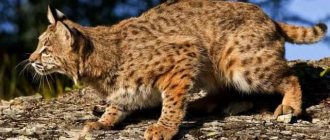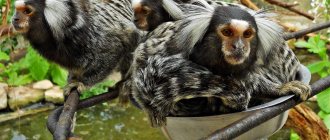The harbor porpoise is a mammal that lives exclusively in coastal waters.
It belongs to the order “Cetaceans” and belongs to the phylum “Chordata”.
This is a unique animal with a wide habitat; fortunately, it is not an endangered species, but it has five subspecies, some of which are at the stage of global extinction from the face of the earth.
In total, there are about 695 thousand individuals in the world population; the Baltic species of these mammals are on the verge of extinction, since, according to scientists, there are no more than 245 adult heads left.
Appearance
This animal may be smaller in size than its fellow bottlenose dolphin, but not by much. The average length of its body reaches up to 2 meters, weight does not exceed 100 kg. It has a powerful and stocky torpedo-shaped body with a triangular fin on its hump.
The head has a blunt shape, and the beak is completely absent. The teeth are sharp, there can be more than 30 of them on each jaw. With age, they can fall out and wear off.
Body color can vary from bluish-gray to light gray. The abdomen is always lighter, the boundaries are unclear. This species more often than other relatives suffers from albinism. Looking at the cute face, one can state that this animal has a good disposition and soul and will not harm a person.
But it should be borne in mind that the wild world still contains many unsolved mysteries that can cause harm. We want YOU, when you see this cute dolphin, to behave extremely carefully and not lose your vigilance.
Porpoises on the ocean floor
So we finally got to these cute and strange creatures. Since our readers like to read about such Lovecraftian weirdos, why not talk about sea-dwelling porpoises. Moreover, this corresponds to the theme of the hub in the “biology” and “popular science” hubs, contrary to some retrospective inhabitants of the hub who think differently….
Skotoplanes in all its glory.
So, porpoises are popularly called Scotoplanes - animals that are deep-sea inhabitants of the world's oceans. They are found at depths greater than 1200–5000 meters [5] and are very rarely found at shallow depths. Essentially, these creatures are sea cucumbers, but only with “legs”. Legs, I, of course, greatly exaggerated this. In fact, they do not have legs in the usual sense of humans.
Specialized vessels (cavities): E) Internal projections of the tentacles; F) Cavity perforated vessels running under the surface of the back; H) Cavities at the ends of perforated elliptical tubular vessels that act as a supporting cane of the ambulacral system (legs) I) An extensive network of vessels from the gonads.
The role of their limbs is performed by body outgrowths, which are greatly enlarged tubes protruding hypertrophied from the body. Under the skin of these tubes there are specialized vessels (smaller tubes), which the porpoise inflates and deflates with muscles, thereby regulating the water supply [1]. It turns out to be a kind of pump that pumps and pumps out water. Thanks to this pump, the tube begins to create strong vibrations and move in the direction where the pig pumped water.
The principle of operation of such limbs is vaguely reminiscent of the principle of operation of “air dancers” controlled by supplying and blowing air.
Sea cucumber (a — tentacles, b — cloaca, c — ambulacral legs on the ventral surface, d — dorsal papillae). The cucumber also moves with the help of its legs, only inside the leg itself there is no branched system of vessels through which water is driven. The role of vessels is performed by the legs themselves, through which water is also driven to fill and relax the appendage [3]
By the way, ordinary sea cucumbers also have small ambulacral legs, but their number is many times greater, and their size is several times smaller, and their operating principle is slightly different (picture) [3]. I will not describe what the ambulacral system is, because I talked about it in an article about a chthonic being, which can be read here.
As for our pigs, in addition to the fact that they have tubes growing on their stomachs, they also have the same growths on their backs.
These outgrowths were even nicknamed “Horns,” although in essence they perform the same function as the “legs” on the stomach. This happens as follows. If a Pig is suddenly turned over by currents (this moment is shown a little in the video) from the stomach to the back, then the back of this animal becomes the stomach, and their front part of the body, on which the mouth and tentacles are located, can turn to the bottom, which saves this animal from unsuccessful attempts return to the previous position [2].
A terrifying sight
Thus, the porpoise resembles a bulldozer, or SUV, which, by the way, greatly changes the surface elements in the ocean, moving through sediments like a tank. As the porpoise moves through the sediment, it destroys the surface and local infauna as it feeds [2].
This animal received the name porpoise because of its appearance, or rather the color of the outer integument of the body. Their colors range from dark gray with colored stripes to light pink and colorless transparent body covers. Light pink and colorless body cover is characteristic of deeper-sea species. It is these animals with a similar color that resemble our typical earthly pigs, which we love to eat.
Oink, oink.
Loss of pigmentation of the outer integument of the body is associated with going to depth. This fact is actually typical of many similar organisms that live in darkness with minimal access to light. Therefore, this will not particularly surprise you. But I think you will be surprised by the fact that these animals breathe through their butts, or rather, through their anus [2]. This is due to the fact that their respiratory system is very poorly developed, but the anus is adapted to absorb dissolved oxygen. It turns out butt Caesar... And it removes waste products... and can breathe at the same time.
Probably, one could be glad that we do not have such a function, but this would not be an accurate fact. I recently read that mammals are quite capable of breathing oxygen through their anus and intestines, with some caveats. Probably such a sign is generally basal and is characteristic of many species of animals, for example, some fish (loaches).
However, it is worth noting that in order for a mammal to breathe enterally, it must be anally administered a “liquid” form of oxygen—a so-called hydrocarbon compound known as a conjugated perfluorocarbon, which has a high ability to dissolve and transport oxygen. This method is now being actively studied as the SARS-CoV-2 pandemic has exceeded the clinical need for ventilators and artificial lungs, leading to a critical shortage of available devices and threatening the lives of patients around the world. This method can significantly reduce the cost of mechanical ventilation equipment and provide, so to speak, an alternative approach to breathing, which, as it turns out, has not yet been forgotten by evolution [7]. Here's the saying about breathing upward... well, you get the idea...
I apologize for going a little off topic. I wanted to show that porpoises have a little more similar traits to humans than previously thought. The animal is very interesting, even because it is not small, because its body size is quite noticeable. A porpoise can be up to 15 cm, which, you agree, is still not so small.
It’s true that it’s better not to pet these animals. Firstly, this is due to their fragile bodies, and secondly, before they die, they will douse you with holothurin.
Chemical formula of holothurin.
It won't kill you, but it will still be unpleasant. Imagine that you are petting a cat, who suddenly pees on you with a huge amount of urine, and then bursts like a balloon, covering you with its jelly organs. Introduced? Something similar can await you with this pig. Speaking of fragility, these animals often end up in the nets of fishing trawlers and fall apart, both from the nets themselves and from the pressure, since some of these animals are still not adapted to life in surface waters.
Since these animals mainly live on the deep ocean floor, especially on the abyssal plains in the Atlantic, Pacific and Indian oceans, they feed by extracting organic particles from deep-sea mud. They can also feed on the rain of rot that forever falls to the bottom from the surface of the ocean [6].
These pigs live peacefully and calmly and, like many sea cucumbers, are often found in huge numbers, sometimes numbering in the hundreds when observed. These creatures most likely do not feel pain, which plays into the hands of the organisms that parasitize them—all sorts of gastropods and crabs [3]. In general, guinea pigs have an excellent and thoughtless life - breathe with their butts and don’t worry about tomorrow!
The article was written by the inspirer of the Phaneroza project, biologist Efimov Samir, and published in the scientific community by Phaneroza.
Sources:
1) Hansen, B. (1972). "Photographic evidence of a unique type of walking in deep-sea holothurians." Deep-Sea Research and Oceanographic Abstracts. 19(6):461–462.
2) Blake, James A.; Maciolek, Nancy J.; Ota, Allan Y.; Williams, Isabelle P. (2009-09-01). "Long-term benthic infaunal monitoring at a deep-ocean dredged material disposal site off Northern California." Deep Sea Research Part II: Topical Studies in Oceanography. 56 (19–20): 1775–1803
3) https://ru.wikipedia.org/wiki/%D0%93%D0%BE%D0%BB%D0%BE%D1%82%D1%83%D1%80%D0%B8%D0%B
4) https://onlinelibrary.wiley.com/doi/abs/10.1111/maec.12396
5) Llano, George Biology of the Antarctic Seas III, Volume 11 of Antarctic research series, Volume 3 of Biology of the Antarctic seas, Issue 1579 of Publication (National Research Council (US)) American Geophysical Union, 1967, p. 57
6) Pawson, D.L.; Vance, D. J. (2005). "Rynkatorpa felderi, new species, from a bathyal hydrocarbon seep in the northern Gulf of Mexico (Echinodermata: Holothuroidea: Apodida)." Zootaxa. 1050: 15–20.
7)https://www.cell.com/med/fulltext/S2666-6340(21)00153-7?_returnURL=https%3A%2F%2Flinkinghub.elsevier.com%2Fretrieve%2Fpii%2FS2666634021001537%3Fshowall%3Dtrue
Habitat and lifestyle
The harbor porpoise dolphin prefers to live at a depth of 20 meters, staying exclusively in coastal waters, but can occasionally visit deep-sea areas of the seas and oceans.
This species itself resembles hermits who roam the seas alone. Sometimes they can gather in small temporary flocks, and even less often in pairs. The maximum speed of movement is 8-9 meters per second or 20 km/h .
To communicate with each other, they furiously use echolocation in the form of all kinds of clicks, sounds and whistles. They rarely jump out of the water. They are very slow compared to other families.
Description
One of the smallest marine mammals. The individuals that make up the porpoise family are quite similar in appearance and skeletal structure to dolphins. They also have a fish-like body with horizontal caudal fins.
For reference: The oldest fossilized remains of porpoises found in the North Pacific Ocean date back to the late Miocene (about 10-12 million years ago). The first true dolphins appeared around this time, and the common ancestor of the two families, Kentriodontidae, died out shortly thereafter.
Although porpoises are not capable of communicating through speech, they still exchange information using various signals in the form of clicks and whistles. Moreover, the signals used by these animals are only pulsed in nature, while at the same time monotonous whistles are recorded in dolphins. Some types of pulse signals are needed for echolocation, others serve to display the emotions of the individual itself. These are fast and agile swimmers, reaching speeds of up to 55 km/h (15 m/s).
Nutrition
In search of food, they are capable of diving to 75 myrtle depths and staying there for no more than 6 - 7 minutes. The hunting area is at the base of the bottom. The diet is very varied, here are just a few dishes from their menu, which they give the deepest preference to:
- Sea crustaceans;
- Small fish;
- Various invertebrates;
- Squid;
- Shellfish;
She should eat more than 4.5 kilograms of seafood per day
to maintain your physical shape. The size of the oral cavity is so small that it is not able to swallow even a 25 cm fish.
How to recognize the disease
In order to detect the disease in time and save your pet, you need to pay attention to the following symptoms:
- the pet does not eat or drink;
- the fur splits, becomes dull and falls out;
- lethargy, shortness of breath, and unhealthy wheezing appear;
- the guinea pig itches and hides from daylight;
- constipation or diarrhea appeared;
- discharge from the nose and eyes;
- the hairs of the fur stick together in the abdominal area;
- irritations, ulcers, and sores on the body were noticed;
- convulsions appear.
As soon as signs of illness are noticed, you should immediately contact a veterinarian.
Reproduction
The porpoise animal gives birth to offspring once a year, more often in June and July. There is usually one cub per litter, but in rare cases there may be two. Scientists have not recorded a specific period for the mating season, so it can be assumed that they mate all year round.
The female's pregnancy lasts 10.5 months. The time will come and a baby will be born whose umbilical cord will break, and a caring mother, hooking the baby’s tiny body to the edges of her mouth, will carry him to the surface so that the baby can take his first breath.
Throughout the year, the female takes care of her offspring, and he, in turn, obediently fulfills all the important requirements of the mother in order to survive in harsh conditions.
She feeds her child fatty, nutritious, and most importantly healthy milk, it is rich in large amounts of protein. Over the course of a year, a child can gain several tens of kilograms.
Lifestyle
Typically, porpoises are timid and fearful animals. They live alone or in small groups. It is quite difficult to see, and even more so, to pursue them, so many residents of coastal areas are not even aware of their existence. The only species that approaches moving vessels is the white-winged pig. It is a fast swimmer, and when the animal emerges, fountains of splashes are noticeable. It is much more difficult to notice the common or finless varieties emerging from the surface, although the first species may jump horizontally out of the water in strong excitement or when chasing fish. The Californian porpoise is especially shy; even very few scientists have ever observed it during the mating season of many species, which occurs during a certain season - usually the end of spring - the beginning of summer. Pregnancy lasts 9-10 months, after which one baby is born. At birth, the baby's body length is 65-85 cm and weighs about 5 kilograms. The grown cub sometimes remains close to the mother even after breastfeeding has stopped.
White feathered pig
The mating season of many species occurs during a certain season, usually late spring - early summer. Pregnancy lasts 9-10 months, after which one baby is born. At birth, the baby's body length is 65-85 cm and weighs about 5 kilograms. The grown cub sometimes remains close to the mother even after breastfeeding has stopped.
Interesting Facts
- The main difference between porpoises and dolphins is that they do not tolerate life in captivity. The maximum period of life in a water enclosure does not exceed three years.
- They are very sensitive to the environment; dirt in sea water is another reason for the death of these peaceful animals.
- Until the mid-twentieth century, they were exterminated en masse.
- It was only in 1964 that fishing for this species was banned at the state level.
- Even today, poachers exterminate mammals; they are not even stopped by sanctions in the form of fines that must be paid to those who conduct illegal fishing.
- In 2007, a remarkable phenomenon happened at the Danish Aquarium: in captivity, a female large porpoise gave birth; for the scientific world this was a real event.
What zone does it live in?
They live mainly in the shelf waters of the oceans and seas of the Northern Hemisphere, as well as off the coast of South America and southeast Asia. They are distributed throughout the continental plume of the Black Sea, and also live in the deep parts of the reservoir and often swim in areas with low salt levels. They are found in the northwestern estuaries. Sometimes you can see this mammal in the waters of rivers located in the south. They prefer to stay in bays, bays, fiords, estuaries and lower reaches of rivers.
Fact! In March-April, some dolphins swim across the strait to Kerch and go back only closer to November.
Blunt-faced dolphins are found in the Sea of Marmara, small groups can be found in the Aegean Sea, but are absent in other parts of the Mediterranean.
CLOSER TO THE SHORE
Porpoises live in temperate and cold waters, preferring not the open sea, but bays, bays or places near river mouths. Most often, these animals stay alone or gather in small groups. Currently, the number of the species is estimated at 700 thousand individuals.
Some taxonomists distinguish three subspecies of porpoises, depending on their range: Black Sea, North Atlantic (or Baltic) and Pacific. All of them are listed in the Red Book of Russia. According to researchers, the Black Sea subspecies is the most vulnerable.
The remaining two belong to category 4: subspecies of uncertain status, small in number and poorly studied. At the same time, porpoise fishing was actively carried out back in the 20th century.
This animal often became a victim of hunters due to its thick layer of subcutaneous fat and meat. Currently, the hunting of porpoises is permitted only in Japan. Nevertheless, they often die in fishing nets, where they end up due to negligence. The number of animals is negatively affected by pollution of the waters of the World Ocean, as well as noise resulting from intensive shipping, military exercises and various underwater work.
Owner reviews
Naturally, high-end guinea pigs are inaccessible to ordinary buyers. In any case, if you plan to breed them, you should opt for purebred specimens.
Interesting to know! In our country, guinea pig breeding has not yet reached such a high level as abroad. Despite this, true connoisseurs of these animals try to acquire individuals that have an attractive and exotic appearance.
It should also be remembered that you cannot cross long-haired and short-haired representatives of the breeds, since the result will be offspring that are low-quality mestizos and no one will allow them to be shown at exhibitions. On top of that, crossing different breeds is also unacceptable because it hinders the improvement of the breed data of any of the species.
Guinea pigs have earned the right to be considered one of the most sought-after pets. Ease of care and maintenance is acceptable for everyone, even novice owners. This is an affectionate and sociable animal that is perfect for families with children.
Lifespan
In the right and comfortable conditions for keeping guinea pigs, the animal can live up to 10 years. There are also individuals 15 years of age. It all depends on diseases, care, breed and other factors. In nature, rodents live much shorter lives. Heavy weight and natural selection have an effect.
Diet[edit]
Finless porpoises are opportunistic feeders, using various types of available food items available in their habitat, including fish, crustaceans and cephalopods. [8] They are reported by [ who?
] eat fish, shrimp and squid in the Yellow Sea/Bohai area and off the coast of Pakistan.
In Japanese waters they are known to eat fish, shrimp, squid, cuttlefish and octopus. [ citation needed
] Seasonal changes in their diets have not been studied.
They also appear to ingest plant material from estuaries, mangroves, and rivers, including leaves, rice, and eggs deposited on vegetation. [ citation needed
]
Longhair
Shaggy breeds have thick, long fur and are in great demand among lovers of fluffy decorative rodents. They were bred artificially and subjected to strict selective selection.
Breeds whose standard officially includes a pure white color include the Peruvian (Angora) and Abyssinian guinea pig, Merino, Sheltie, Coronet, Texel and alpaca.
Abyssinian
This is the most interesting and most recognizable breed. The Abyssinian guinea pig has one very striking distinctive feature that immediately sets it apart from other varieties.
The Abyssinian coat must have so-called rosettes. They are a kind of funnels and appeared as a result of a genetic mutation.
Each Abyssinian guinea pig has about 6-10 rosettes on its body. They are located throughout the body and are absent only on the head and belly of the animal. Occasionally, the Abyssinian guinea pig has so-called “double rosettes.”
Their maximum number can reach 30 pieces. The animal's long fur can be painted in almost any color, including white.
Alpaca
Alpaca guinea pigs are covered with long, curly hair, the structure of which is more reminiscent of sheep's fleece. It grows from the tail to the head and forms a pair of rosettes on the rump and one on the crown. Representatives of the alpaca breed have coarser hair on their faces.
The color of the animals can be almost any color, including white. Occasionally among alpaca guinea pigs there are two- or three-colored individuals.
Coronet
The Coronet guinea pig has very long hair that flows down the sides and does not cover the face. There is a single rosette on the animal's head.
The coronet guinea pig comes in a variety of colors. It can be either monochromatic or combined. It is noteworthy that the white coronet is not very popular among breeders. It is believed that outwardly it loses to its brighter brothers.
Texel
The Texel cavy is covered with curly hair, the length of which reaches 15 cm. It grows from the head to the back of the body and cascades down the back.
The Texel guinea pig can have almost any color. Among the representatives of the breed there are even white individuals.
Merino
The breed was created by crossing a Coronet and a Texel. It has a crown-shaped rosette on its head and long, wavy fur that is white, gray or other colors.
Sheltie
The Sheltie guinea pig has long hair that does not flow along the sides, but simply falls back. More dense hair grows on the animal’s head, creating a kind of mane.
The Sheltie can have almost any color. But the white representative of this breed attracts less attention than his colored counterparts.
Peruvian
The Peruvian pig is also called the Angora pig. She has an aristocratic appearance and beautiful fur. There are rosettes on the nose and sacrum. The animal's muzzle is covered with long bangs. The Peruvian pig, or angora, weighs up to 1.5 kg and lives up to 6 years. It is painted in almost any color, including white.
Most often, Peruvian guinea pigs have silver-gray fur. Solid white color is extremely rare in the breed. Therefore, such caves are highly valued by breeders.
The long, soft coat of Angora Cavies grows straight forward. She needs careful care. Peruvian guinea pigs need to be brushed and trimmed regularly. And white animals can occasionally be washed with special shampoos for rodents.
Training
The guinea pig is trainable. Different individuals may need additional time to learn.
Most popular tricks:
- respond to a name and come to a call;
- stand on hind legs when required;
- run in a circle for a treat;
- roll the ball and climb over the hoops;
- go to the toilet in the tray.
